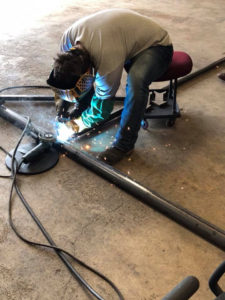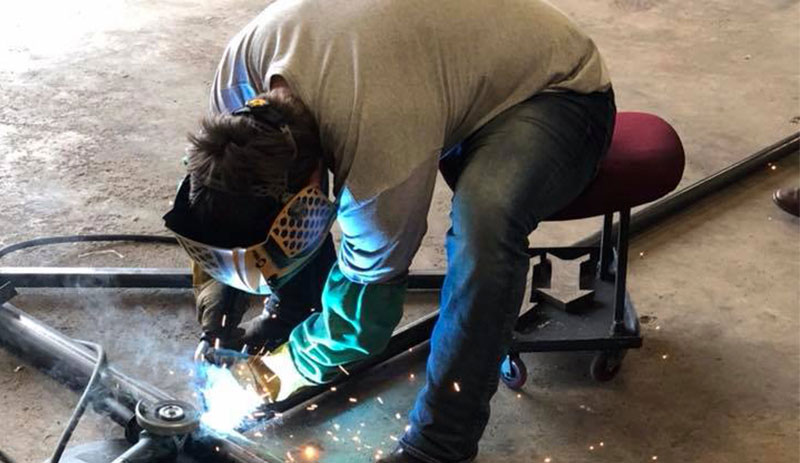by Dianna Brodine, managing editor
Plastics Business
The skilled labor crisis is the top issue facing manufacturing companies today, and the solution may lie within the school system, where a captive audience of young adults is making decisions about prospective careers. But, how does a manufacturing company penetrate the educational system to create a funnel of future employees? What shift is required at the curriculum level to accommodate preparation for careers in technical fields?
The yardstick that marked college attendance as the only measure of postsecondary success is breaking. States are recognizing the critical need for a pipeline of employees in the trades, and educational metrics are changing to redefine success for students.
College and career readiness in Kansas
The Kansas State Department of Education has published its definition of success for students:
A successful Kansas high school graduate has the academic preparation, cognitive preparation, technical skills, employability skills and civic engagement to be successful in postsecondary education, in the attainment of an industry-recognized certification or in the workforce, without the need for remediation.
“For a long time, high schools were not preparing all kids for success at a postsecondary level,” explained Mike Mathes, former superintendent of the Seaman School District in Topeka, Kansas (total enrollment: 3,867 and one of four school districts in the city of Topeka), and current superintendent of North Lyon County School District (total enrollment: 430 and providing educational services to six rural communities). “Now, we are focused on getting kids prepared to be adults. Kansas is ahead of the curve in understanding that schools need to be helping students with college and career readiness.”
To assist students in achieving those outcomes, a recent statewide initiative is providing incentives for those interested in pursuing Career Technical Education (CTE) while still in high school. According to the Kansas CTE website:

For several decades, Career and Technical Education (CTE) has been evolving. No longer offering only traditional vocational education, CTE now offers a diverse range of subjects and career fields, including a number of science, technology, engineering and mathematics (STEM) subjects. In addition, the distinction between CTE and academic programs is slowly disintegrating … CTE plays a powerful role in preventing students from dropping out and provides a variety of opportunities for postsecondary success and employment, including pathways to a bachelor’s degree.
The Kansas CTE program offers 16 pathways, including Agriculture, Food and Natural Resources; Architecture and Construction; Health Sciences; Manufacturing; and Transportation, Distribution and Logistics. State-sponsored funding is available to cover the cost of tuition for high school students enrolled in a Career Technical Education course at a community or technical college. The funding also helps school districts pay for the costs of transporting those students to and from the community or technical college.
“This type of education requires a change in mindset,” said Mathes. “Schools have to change, because right now school districts expect kids to be in attendance. Parents will have to accept that a kid may not be in a school building all day long. Curriculum also becomes a challenge, because we still are required to teach subjects like English, math and science. It’s not an easy logistical thing to figure out.”
Easing the way is a state department of education that has shifted its metrics and its definition of success. Postsecondary attendance and completion is one of the five outcomes set forth by the state for measuring progress toward achieving its vision for education, and the data include two-year, four-year, graduate, trade and vocational schooling. “To be accredited, we are following kids for two years after graduation, and the schools are scored based on the percentage of our kids who are successful,” Mathes explained. By including trade and vocational schools in its definition of success, the state has paved the way for schools to include that programming within the educational day, although barriers still exist.
Mathes continued, “To succeed in developing curriculum that gets kids ready for college and careers after high school, we have to keep asking ourselves ‘What is school supposed to look like?’ It’s not as easy as it sounds.”
Apprenticeship initiatives in North Carolina
In North Carolina, apprenticeships are providing a way for manufacturing firms to reach local high school students. At Superior Tooling, Inc. a Wake Forest, North Carolina, company specializing in plastic injection molds, President Robbie Earnhardt has eight apprentices on staff – an impressive number for a company with a total employee count of 28. “We’ve got a very successful apprenticeship program, and the state is helping us with that by being very proactive on getting into the schools,” said Earnhardt.
North Carolina has several programs aimed at increasing access to technical education. The North Carolina Tuition Assistance Program offers help to active members of the Army and Air National Guard. Apprenticeship 2000 is a four-year technical training program created in 1995 to develop high school juniors and seniors who are interested in fields such as tool and die making, moldmaking and machining. And, in the Greensboro area, the Guilford Apprenticeship Partners (GAP) works to bridge the gap between high school graduates and career opportunities in advanced manufacturing and service fields.
Still, Earnhardt puts in a significant amount of personal effort to bring apprentices into his facility. “It starts with the teachers,” he said. “We have them into the facility for a luncheon right after school starts and explain the program. Then, they help us locate the kids within the schools who they think qualify for these programs and who have shown an interest in the trades we’re offering. We want to have a targeted audience, rather than speaking to the entire school.”
To begin their apprenticeships, students work half a day at Superior Tooling and spend half a day in the school building during their senior year. “The schools have been working with us to get the classes in line so the students can accomplish that,” said Earnhardt. Upon graduation from high school, the apprentices work for four days a week and attend an area technical college one day a week, which leads to an associate degree within three years. Earnhardt said the bureaucracy made the scheduling difficult.
“School has to change,” he explained. “The culture has to change – the culture of our schools and our parents. They have to understand there are other opportunities out there, and that apprenticeships today can be a true educational experience that combines learning a trade and earning a degree. By working with the counselors and teachers, we’re reaching the right student audience. It’s a matter of educating the educators!”
By participating in parent/teacher nights, career fairs and Saturday morning orientations with students and parents, Earnhardt is continually explaining not just the Superior Tooling program, but all the programs that are offered. “It’s a continuous battle to change the culture, because they don’t understand what success the trades can offer,” he said.
Success in Wisconsin at Cardinal Manufacturing
One of the most recognizable examples of the success that can follow when industry and education partner is seen in Cardinal Manufacturing, located within Eleva-Strum High School in Strum, Wisconsin. Cardinal Manufacturing is a school-based, student-run manufacturing business. Students in the program work with local businesses and individuals on manufacturing tasks that can range from a simple repair job to welding, woodworking and custom-designed and -machined parts.
The program has garnered so much attention across the US that the school offers one-day workshops for other education and industry partners that want to replicate its success. Attendees of these sessions learn how Cardinal Manufacturing got its start, meet the student employees and business partners, and hear from administration about their concerns and day-to-day management issues.
“Schools from around the country come in to see what we’re doing, spending an entire day here so they can implement it in their own communities,” said Craig Cegielski, instructor for the Cardinal Manufacturing program.
The Cardinal Manufacturing program is an integrated part of the school day. “We have an eight-period day,” Cegielski explained, “and the 7th and 8th period of the day are Cardinal Manufacturing hours. We run the program from the high school shop area.”
Students have to apply for acceptance into the Cardinal Manufacturing program prior to their senior year after taking certain prerequisite classes. By the time they reach their final year of high school, most of their core graduation requirements have been met, which makes it easier to accommodate Cardinal Manufacturing within their schedules.
“By building the program here and integrating it into the school day, we avoid transportation issues, and there are no conflicts with sports after school,” he explained.
Because the program is run from the high school shop, the equipment is utilized to build skills for students as they progress from 8th grade through 12th. “That makes our model easy to replicate,” said Cegielski. “Most schools have the space, the teacher and basic equipment, but there isn’t a budget for tooling and materials. This utilizes what schools already have and brings it to another level by bringing in industry partners.”
“You’ve got to make a plan,” he continued. “This isn’t something you start overnight. If schools are running a high-level technical education program and already have a pipeline of classes in place – such as Metalworking 1, 2 and 3 – with a pipeline of students already interested, then it’s easy. You add a class called “Student-Run Business” and start marketing. But, some schools only have an older shop area and one teacher, so you have to figure out where you’re at.”
Cegielski said the first step is to sit down with the key players – the teacher, the principal, the school board – and to reach into the community to find industry partners. Then, create a plan. “That’s what we do with the workshops we hold – we explain what we do and show them the model we have designed to start a student-run business.”
By creating a marketable, sellable product, the program brings in revenue, which is necessary in these times of tightened school funding. “Some schools simply do not have the funding,” he explained. “We have 160 students in the high school, so resources are limited. Cardinal Manufacturing brings in revenue to help us afford tooling, equipment and materials.”
While Cardinal Manufacturing teaches employable skills in the manufacturing, machining and welding trades, Cegielski said the benefits reach much further. “In so many classes, we tell kids exactly what to do and what to study in order to get the grade. Here, we give them a task and a timeline. From there, the students have to call, design CAD files, fabricate the product and market it to potential consumers. Throughout this entire process, we model and critique their soft skills – sending professional emails, meeting deadlines, working together with multiple students and problem solving. As a high school teacher, that’s the single largest benefit of this program. We can make a big difference in students’ confidence and communication skills, and that carries with them wherever they find employment after high school.”
More information about the Cardinal Manufacturing model: www.cardinalmanufacturing.org.
The site contains resources, including links to its Facebook page, information about upcoming workshops and the annual open house, and links to YouTube videos that provide an inside look into the program.





